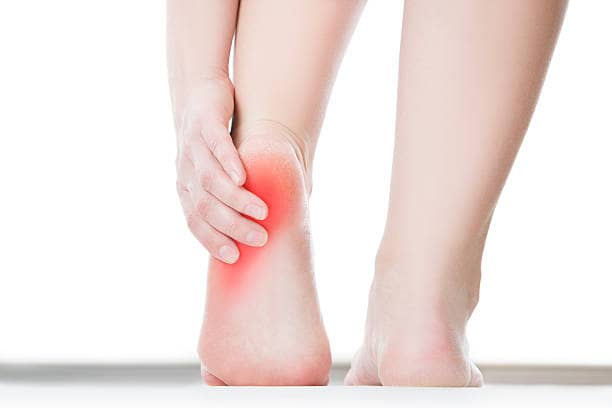
OVERVIEW
Available in 50 states. No insurance needed.
Common Symptoms of Heel Pain
Heel pain can manifest in various ways, making each individual’s experience unique. One common symptom is a sharp or stabbing sensation in the heel, especially when standing or walking. This discomfort may be more pronounced after periods of rest, such as getting out of bed in the morning. Another telltale sign of heel pain is tenderness or inflammation around the affected area, often caused by conditions like plantar fasciitis or a heel spur.
Individuals with heel pain may also notice a dull ache that persists throughout the day, impacting their mobility and overall quality of life. Some people describe feeling like they are walking on pebbles due to the irritation caused by bone spurs under the heel. It’s essential to pay attention to these symptoms and seek appropriate treatment to address the root cause of your discomfort.
Common Causes of Heel Pain
Individuals can develop heel pain from various factors, including overuse, injury, or certain medical conditions. Plantar fasciitis, Achilles tendinitis, and heel spurs are among the most common causes of heel pain that can affect people of all ages and activity levels.
Plantar Fasciitis
Plantar fasciitis is an inflammation of the fibrous tissue along the bottom of your foot that connects your heel bone to your toes. This condition causes stabbing pain near your heel, especially with your first steps in the morning.
The pain usually decreases as you move more, but it might return after long periods of standing or getting up from sitting.
MyInstantMD’s online doctors can help diagnose plantar fasciitis through a virtual consultation. During this process, you will be asked targeted questions to determine if your symptoms point towards plantar fasciitis, guiding the decision on the best treatment plan. Our doctors may recommend stretches, icing, and pain relievers like naproxen or ibuprofen to reduce inflammation.
Achilles Tendinitis
Achilles tendinitis is an inflammation of the Achilles tendon. This tendon connects the calf muscles to the heel bone. Overuse, sudden increases in physical activity, or wearing ill-fitting shoes can cause Achilles tendinitis.
Symptoms include pain and stiffness along the back of the foot and above the heel. This pain is often worse in the morning and after exercising. Treatment for Achilles tendinitis may involve rest, ice, compression, and elevation (R.I.C.E.).
Stretching exercises and physical therapy can also help relieve pain and promote healing. In severe cases, a doctor may recommend anti-inflammatory medications or orthotic devices to support the foot and ankle.
MyInstantMD’s experienced doctors can provide personalized treatment plans for Achilles tendinitis through virtual consultations. We will assess your symptoms, medical history, and lifestyle factors to develop a tailored approach.
This may include guidance on stretching, icing, and modifying activities to reduce strain on the Achilles tendon.
Other potential causes
Several less common conditions can also lead to heel pain. Heel bruises from a bad fall or bump may trigger discomfort. Stress fractures, which are tiny cracks in the heel bone, can happen due to repetitive strain or sudden injury.
Nerve problems like tarsal tunnel syndrome compress a nerve under the foot, causing burning, tingling, or numbness in the heel. Diseases such as rheumatoid arthritis and lupus sometimes affect the feet and heels.
Rarely, tumors develop in the heel area, resulting in pain. If home remedies and rest don’t ease heel pain, it’s wise to consult a doctor for proper diagnosis and treatment.
Available Treatment Options
When it comes to treating heel and foot pain, there are various options available that can help alleviate the discomfort and improve mobility. One of the common treatments for heel pain is wearing supportive footwear that provides cushioning and stability for the feet. This can help reduce pressure on the heels and prevent further irritation.
Physical therapy is another effective treatment option for addressing heel pain. A trained therapist can recommend specific exercises to stretch and strengthen the muscles in the feet and lower legs, which can help relieve tension on the plantar fascia.
In more severe cases of heel pain, medical interventions such as corticosteroid injections may be recommended to reduce inflammation and provide relief from sharp pain. However, it’s essential to consult with a healthcare professional before undergoing any invasive procedures.
Overall, finding the right treatment approach often involves a combination of methods tailored to individual needs based on the underlying cause of heel pain. By exploring different options under guidance, individuals with heel discomfort can find relief and regain their quality of life.
At MyInstantMD, you can connect with skilled doctors who can develop personalized treatment plans to treat your heel pain.

Prescription Medication
Prescription medication can be a valuable option for treating heel pain, especially in cases where over-the-counter remedies have not provided relief. Our doctors may prescribe anti-inflammatory drugs to help reduce swelling and alleviate discomfort associated with conditions like plantar fasciitis or heel spurs.
In some instances, corticosteroid injections may be recommended to target inflammation directly and provide more immediate relief from sharp pain. These injections are typically administered by a healthcare professional in person and can offer significant benefits for those experiencing persistent heel pain.
It’s important to follow the doctor’s guidance closely when using prescription medication for heel pain treatment. With the right prescription, you can take steps towards managing your heel pain effectively and improving your overall quality of life.
Heel Spurs
Bony growths that develop on the underside of the heel bone are known as heel spurs. These spurs form when the plantar fascia, a thick band of tissue that runs along the bottom of the foot, pulls away from the heel bone due to excessive strain or pressure.
Heel spurs often cause sharp pain in the heel, particularly when taking the first steps in the morning or after long periods of rest.
While heel spurs can be painful, many people with this condition experience no symptoms at all. Treatment for heel spurs typically involves a combination of rest, ice, and stretching exercises to reduce inflammation and alleviate discomfort.
Available in 50 states. No insurance needed.
Over the Counter Medications and Self-Care Tips

For those suffering from heel pain, there are various treatment options available both online and offline. From prescription medications to over the counter remedies and self-care tips, managing heel pain can be effective with the right approach. Remember to consult a healthcare professional for proper diagnosis and personalized treatment recommendations. Take proactive steps towards alleviating your discomfort and get back on your feet pain-free!

Available in 50 states. No insurance needed.
Reasons for further heel pain treatment
Sometimes, heel pain needs extra care. If telehealth services can’t fully treat your heel pain, MyInstantMD doctors may refer you to other specialists. They might suggest seeing a podiatrist, orthopedic surgeon, or physical therapist for hands-on care.
These experts can provide treatments like custom orthotics, manual therapy, or even surgery if needed.
MyInstantMD’s referral process is simple and stress-free. The doctors work with a network of trusted local providers. They’ll help you find the right specialist and coordinate your care.
Benefits of Treatment Online
Online heel pain treatment offers a convenient and affordable way to access quality healthcare from the comfort of your home. With MyInstantMD’s secure telehealth platform, you can easily connect with experienced doctors for personalized treatment plans.
Convenience and Accessibility
Our online heel pain treatment offers unparalleled convenience and flexibility. With our virtual consultations, you can access experienced doctors from the comfort of your home or office. No more waiting rooms or rushed appointments.
Our user-friendly platform makes it easy to connect with a healthcare professional who can provide personalized treatment recommendations tailored to your specific needs.
Say goodbye to the hassle of traveling to a doctor’s office or rearranging your busy schedule. With our online treatment, you can receive the care you need without disrupting your daily routine.
Our secure and confidential telehealth system allows you to discuss your heel pain concerns with a qualified physician, receive a diagnosis, and get started on a treatment plan, all from the convenience of your preferred location.
MyInstantMD’s affordable telemedical services make treatment accessible for those with limited insurance coverage or high deductibles. Our company’s affordable pricing ensures that our patients can receive the care they need without breaking the bank.
Avoiding exposure to other illnesses
Online heel pain treatment reduces your risk of catching other illnesses. Waiting rooms can expose you to germs from sick patients. Telehealth lets you get care from home.
Protect your health and get started now to experience relief without leaving your couch.
Available in 50 states. No insurance needed.
Fast and secure Telehealth platform
Our telehealth platform is fast and secure. It only takes about 5 minutes to complete our online questionnaire for our providers to review and send you a personalized treatment plan.
We use HIPAA-compliant technology to protect your personal health information.
This ensures only authorized individuals can view sensitive medical details. You can feel confident your privacy is safeguarded when using our platform.

Get Started Today
Ready to start feeling better? Get started now with MyInstantMD and get the relief you need from your heel pain. Our secure telehealth platform makes it easy to connect with a board-certified doctor who can provide personalized treatment options tailored to your needs.
Available in 50 states. No insurance needed.

Acute medical treatment in
3 easy steps

1
Answer a few simple questions

2
Provider will then review your information

3
Send prescription to the pharmacy of your choice
FAQs
Common causes of heel pain include plantar fasciitis, Achilles tendonitis, bursitis, heel spurs, stress fractures, and arthritis. Wearing ill-fitting or high-heeled shoes can also contribute to developing chronic heel pain.
Yes, you can receive heel pain treatment online through our telemedicine service which is easy, fast, and secure.
Home remedies for heel pain include resting the affected foot, applying ice or cold therapy, stretching exercises, wearing supportive shoes with good arch support, and using over-the-counter pain medications like aspirin or ibuprofen.
If you experience severe, persistent heel pain that limits your daily activities or is accompanied by swelling, redness, or numbness in your foot, it’s important to consult with a healthcare professional promptly for an accurate diagnosis and appropriate treatment plan.
Yes, regularly wearing high heels can lead to various foot problems such as bunions, hammertoes, ingrown toenails, metatarsalgia (pain in the ball of the foot), and even nerve damage. It’s best to limit time spent in high heels and alternate with more comfortable, supportive footwear.
Stretching exercises targeting the calves, Achilles tendon, and plantar fascia can help prevent and alleviate heel pain. Rolling a tennis ball or frozen water bottle under the arch of the foot can also provide relief. Low-impact activities like swimming and cycling are gentle on the feet while maintaining fitness.



